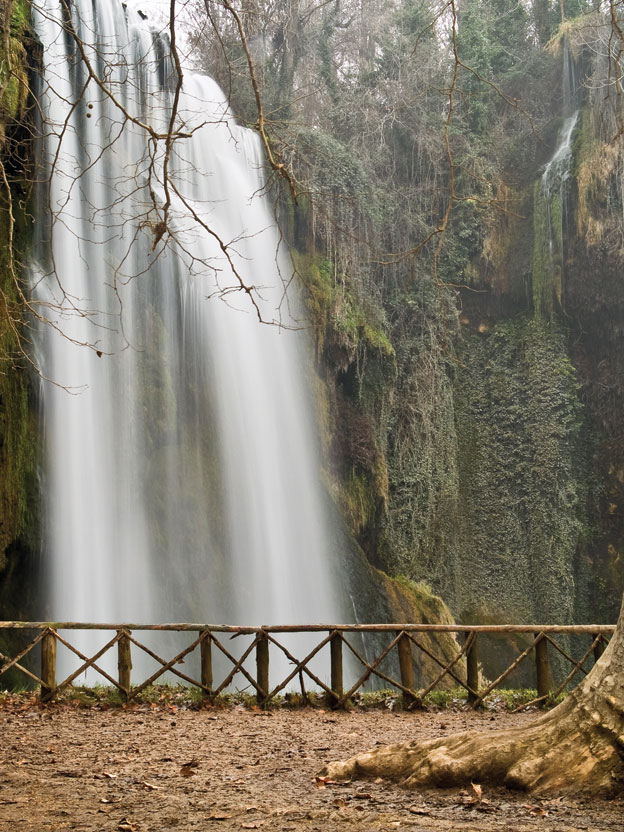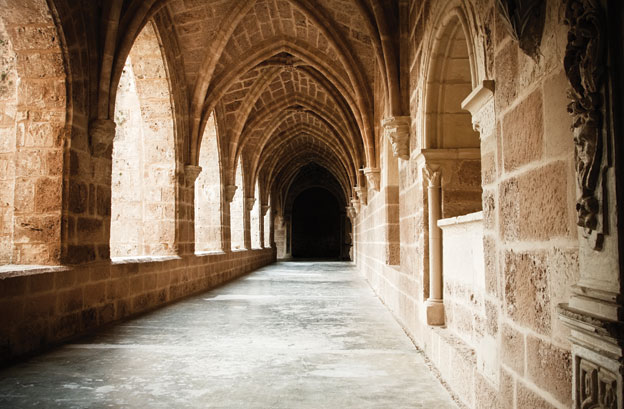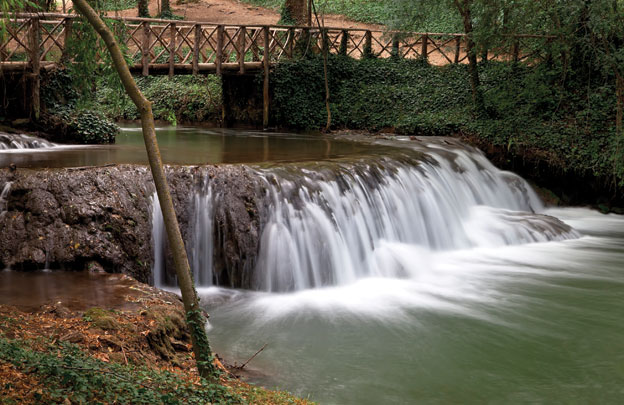(Above): Inner cloister at the Monasterio de Piedra.
Louise orders a sherry and I asked for a dry vodka martini with an onion. “You’re in real trouble, podner,” she whispered with a slight smirk. “What do you mean? It’s a simple request.” Louise smiled and responded, “dinner tab says I’m right.” What else could I do? “Done.”
When the barista brought the sherry in a slim, crystal glass and a tall, narrow glass obviously filled to the brim with vodka and a lone onion floating forlornly on the top - for a few minutes and forgotten. Dinner was a succulent success and, thankfully, moderately priced. Locally farmed trout almandine, vegetables from neighboring farms and the wonderful red and white wines of Spain.
Thus were we introduced to the visually beautiful haven for quiet meditation and sharing. Built in the 12th century, its full designation, El Monasterio de Nuestra Señora de Piedra (Monastery of our Lady of Stone), well describes its noble visage; the keep is now a splendid lodging for travelers. Not far from the city of Zaragoza, its massive stone structure was built to protect the monks from the hordes of Muslims then occupying the area once overrun by Romans and Visigoths.
Located in one of the most barren areas of the “Cordillera Iberica,” the Natural Park is now one of the loveliest and most visited parks in Aragon. The Piedra River canyon nearby to the monastery is a long, slender grouping of paths, caves, multitude examples of greenery, flora, stone, lagoons and waterfalls as far as the eye can see.

(Above): A waterfall at the Monasterio de Piedra Natural Park, is just one example of the abundant natural beauty surrounding the monastery.
A stroll down the canyon is one that should take you two, if not three days. The waterfalls, one after the other lining the canyon, are overpowering in their sound and sight. Some you can walk behind, stand above or dash through - if you are of the mind. Behind one is a woman selling soft drinks and sweets. Some are huge, others simple rivulets dancing down the limestone walls. The flora and fauna abounds, equaling the immensity of the falls. Some will whisper a few of the falls are man-installed, but no one will so state out loud.
Wherever you go, you will find so many versions of trees such as oaks, pines chestnut and more, thickets of lavender and blackberry, cultivated almond and cherry trees. The aroma of mint is overwhelming. Louise and I took the Natural Park one part a day, giving us time to stop and absorb the beauty, the unseen but truly felt surrounding environment of sound and fragrance.
Animals and birds were everywhere; wild boars, foxes, martens, badgers, deer and more. Overhead the skies are a ballet of golden eagles, hawks, peregrine falcons, vultures and owls, among others. The waterways are surrounded by the symmetry of herons and cormorants, teal, mallards, painted frogs, newts and lizards. Birders will find quail, Barbary Dove, robins, larks, finches and the numbers go on and on. Once a fish farm harvesting salmon and brown trout, the river is now a fisherman’s paradise with the introduction of carp, rainbow trout and catfish.
At the same time we visited the deep history of the Monasterio de Piedra. Originally founded by thirteen Cistercian monks from Poblet Monastery in an old castle on the edge of the Piedra river. Constructed as a minor fortress, the monastery was a substantial stone edifice, church, corrals with an emphasis on agriculture as well as evangelizing and colonizing the region. Wherever you wander you are awed by the thick stone walls and large archways. We spent two days just learning the all-embracing and life-changing history of this living edifice touring the so many examples of the monastery‘s provenance. It’s survival through one of Spain’s most torturous periods is the story of all of Spain.

(Above): Monastery interior of the Monasterio de Piedra, Zaragoza, Spain.
Now a Paraje Pintoresco Nacional or national monument park, the Monasterio de Piedra began its transformation into the extraordinary venue of today with the vision of Juan Federico Muntadas. Juan was the son of the original purchaser in 1840, Pablo Muntada Campeny, a wealthy Catalonian merchant. Muntadas designed a “people park” with comforting plantings, caves and walkways to enjoy the dramatic falls. He opened the caves to the public and in 1867 created the first fish farm in Spain. The most perceptible site today to absorb the life of this grand structure is the Chapter with its extensive restoration. Adjoining the Faculty room the architecture is a place to visit all the history wrapped in the 1000-year-old walls.
After six marvelous days of traveling in time, as it were, Louise and I were back on the road with memories that have never left.

(Above): Waterfalls are in abundance at the Monasterio de Piedra Natural Park, Zaragoza, Spain..
Time and progress has abandoned the misbegotten “martini” to an international concept of the modern version now served in the “Salon Don Gaufrido” bar-café, offering a world of beverages and light meals. Monasterio de Piedra has matured into a stellar destination venue with all the contemporary conveniences. The 62 rooms are large, handsome and comfortable.
Complimenting all this are two fine dining restaurants, the “Old Stone” and “Restaurant Kings of Aragon.” A fully equipped spa offers a time to leave the mechanical world and time to reflect on your day in the Natural Park or a swimming pool to work out those hiking kinks.
History and the sybaritic pleasures are melded with a gallery of Moorish art and its regional Islamic past or you can spend time in the romantic outdoor “Corner of the Poet“ garden. For the wine lover there is a tour of local wineries and the monastery’s wine museum. The Monasterio de Piedra offers such a broad menu of services, physical pleasures and eternal gifts for the mind and memory, it is best to go to the Monasterio’s extensive Website (please see the box below for the many select addresses).
MONASTERIO DE PIEDRA
General Information: http://www.monasteriopiedra.com/
Reservations: Hotel, Kings of Aragon {hotel@monasteriopiedra.com}
Booking Agent: grupos@monasteriopiedra.com
*MONUMENTAL Tour
Tour of different units of the Cistercian Monastery (year 1195): cloister, Chapterhouse, Baroque Altar, Church, Museum of the wine D.O. Calatalyud (Old Cilla), tripych reliquary reproduction of the Monasterio de Piedra (year 1390 - in the refectory or dining room) and Calefactory.
Please check Rates and Schedules Website for different seasonal hours.
|